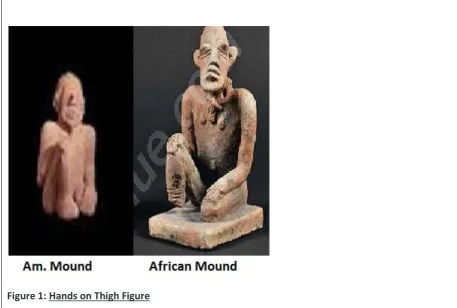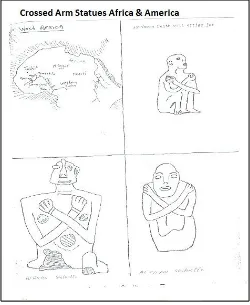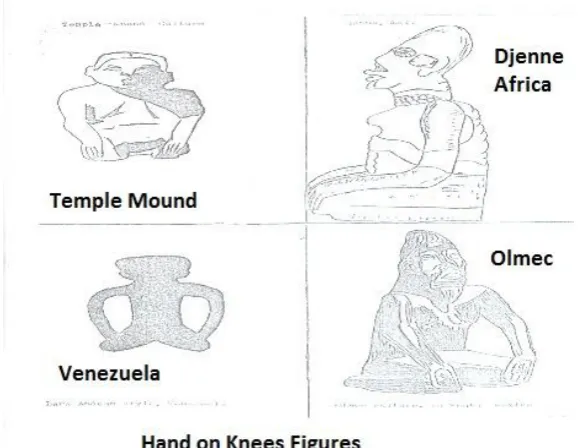WHO WERE THE MOUND BUILDERS IN THE UNITED STATES Dr. Clyde Winters
Uthman dan Fodio Institute Chicago, Illinois 60643
Abstract
In this paper we test Leo Weiner’s theory that the builders of the mounds in the United States were people from West Africa. In 1310 Abubakari, King of the Ancient Empire of Mali, led 25,000 colonists to settle the New World.The research has yielded information that the Malian explorer-colonist left beautiful mound structures and writing. The results indicate that the African and American mounds have statues built in the same style with many of the same features. They support Wiener’s theory that the Mande speaking people built some of the Mississippian mounds.
Key terms: Black Native American Mali, Mississippian culture
In the 1500’s European explorers and conquistadors travled the American southeast and found numerous Native American populations’ Often they found Mongoloid and Black Native Americans living near one another in separate villages. Explorers, such as Hernando de Soto and Jacques Le Moyne sound the Native Americans building and /or living on the mounds (Hodges and Lewis, 1907; O’Connor,1995; Squier and Davis,1848; Young and Fowley,2000 ). They reported that the mounds were used for habitation, the King’s residence or burial mounds for elites.
Who were the Mound Builders in the United States? Granted, most researchers agree that the Mound Builders were probably Native Americans but, controversy surrounds the ethnicity of the Mound Builders.
Leo Wiener (1922) claimed that many of the mound builders of the United States and Mexico were Manding speakers. He saw the mounds as defensive structures built on the African type of stockade model. Wiener noted that: "I have already pointed out that the mounds of the Mound-builders were town sites, with the hill for the caciques [chiefs] residence and temple, just as in the Sudan, and that the North American stockade is identical with the one in West Africa" (317). In this paper we will test this hypothesis by comparing artifacts found in American mounds and African mounds .
Results
We find many similarities between the art styles of the inhabitants of the mounds found in the area that encompassed ancient Mali, and the mounds built in the United States and South America.
People in West Africa during King Abubakari’s time were not ignorant of the nautical sciences and navigation. West Africans had a highly developed knowledge of boat technology and navigation sciences. The canoes they built from gigantic trees were as big as the boats sailed to America by Columbus.
Much of what we know about African nautical sciences comes from Vasco da Gama. Vasco da Gama is said to have found information about the West Indies from Ahmad b. Majid, whom he met along the West Coast of Africa (Bazan, 1967). Majid wrote a handbook of navigation on the Indian Ocean, Red Sea, the Persian Gulf, Sea of Southern China and the waters around the West Indian Islands. Majid is also said to be the inventor of the compass (Ferrand,1928).
The vast majority of Native Black Americans lived in California, or along the Southeastern seaboard in North America. They belonged to many Confederations including the Muskhoean and Algonquin. Some of their tribal names include Choctaw, Tuscarora, Secolan, Tamacraw, Nanticoke, Kashita (Kauche-te), and Yamasee to name a few. The BNA tribes mainly belonged to the Muskhogean and Algonquin Confederacies.
The only occupied mounds seen by Europeans were those built by the Black Native Americans between the Carolinas and Florida the principal location of mounds in the southeastern part of the United States. Hernando de Soto the only European to see occupied mounds tells us much about their construction and use.
The mounds of ancient America follow the lines of the Mississippi and Ohio rivers, and outlying regions as well. They vary in size from colossal mounds in Illinois to mere blisters rising from the earth.
The mounds in the United States are usually found near rivers. In the Ohio Valley 10,000 mounds have been discovered. In the north the mound zone begins in western New York and extended along the southern shore of Lake Erie into what is now Michigan, Wisconsin and on to the states of Iowa and Nebraska. In the southern United States the mounds lined the Gulf of Mexico from Florida to eastern Texas, and extended up through the Carolinas and across to the state of Oklahoma.
Most, if not all of these mounds had long been abandoned by their former inhabitants when they were discovered by the Americans, 200 years after the Spanish had witnessed the Yamasee building mounds. The excavated mounds have yielded human bones, weapons, tools, inscriptions and jewelry.
Statues of Africans have been found in these mounds. There were three types of African statues found in the ancient mounds excavated in North America and the western Sudan.
In Figure 1, we see the humanoid figure in a sitting position with their hands on the thigh and right knee pointing up while the other knee is resting on the ground are found in Tennessee and Indiana at the Angel site.
In Figure 2, we see the most common type of statue found in North America, that is the statues of humanoids in a sitting position with the hands placed across the chest have also been found at Etowah and Temple mound sites in Tennessee and Georgia. It is also interesting that anthropomorphic statues found in Polk County, Georgia are analogous to statues found in Mauritania.
Figure 2: Crossed Arms Figure
Black Africans are characterized as being broad faced, full lipped, illustrating prognathism , large boned with fleshy noses. Samuel Morton in Crania Americana , written in 1839 noted that Adena people possessed "ponderous bony structure[s]...large jaws and broad face". This description of the Adena, fits exactly the description of the West African type.
In Figure 3, we find the third type statue , found in West Africa and North America. These statues have as its base the feet and buttocks.
Figure 3: Hands on Knee Figures
Figure 4: Gorgets
Discussion
The Manding may have also constructed the Temple Mounds. In these mounds we see artifacts analogous to those discovered in Africa. These mounds were built between A.D. 700 and 1700. The Temple Mounds were built in the central Mississippi Valley, Arkansas, southern Missouri, southern Illinois and western Tennessee. All of these regions of the Southeast were inhabited by Black Native Americans.
Other sculpture heads and figurines of Africans have been found on the banks of Paint Creek ,near Chillocothe,Ohio; Tennessee; Mississippi; and on Green Flats in Virginia, which wear African headdresses ,skull caps and facial striations identical with those of the Manding. We also find the depiction of Africans in carvings from Spiro Oklahoma. At Spiro Mound African faces were carved on shells and the Manding cross sign placed on the palms of the hands on one artifact (See: Figure 4). This cross in the Manding script meant "righteousness, purity". Other inscribed works of art from the Moundville site in central Alabama also show Manding signs, especially the Manding cross.
In addition to the transfer of African style statues in the mounds the Malians also left many inscriptions. These inscriptions and statues support the African origin of many mounds in the United States.
In conclusion, this comparison of artifacts in the American and West African Mounds supports Weiner (1922) hypothesis that the Mound builders were probably of Mande origin. It would appear that some of the 25,000 colonist taken to America by King Abubakari, landed in the United States and built mound structures for habitation and defensive purposes.
A figurine found in a cemetery at Nashville, Tennessee was of an African women, while another African statue was found at Clarksville, Tennessee in 1897. These statues as well as heads on the gorgets from the Missouri mounds show analogous striations found on the faces of Manding clansmen (Wiener,1922).
References:
Alcina-Franch J. Los orígenes de America. Madrid: Editorial Alhambra, 1985.
Arnaiz-Villena A, Vargas-Alarcón G, Granados J, Gómez-Casado E, Longas J, Gonzales-Hevilla M, Zuñiga J, Salgado N, Hernández-Pacheco G, Guillen J, Martinez-Laso J.(2000). HLA genes in Mexican Mazatecans, the peopling of the Americas and the uniqueness of Amerindians. Tissue Antigens. 2000 Nov;56(5):405-16.
Bazan, R.A.G.(1967) Latin America the Arabs and Islam,,Muslim World, pp.284-292; Ferrand,G. (1928). Introduction a l’astrnomie nautique des Arabes, Paris.
HodgeF. W. and T.H. Lewis,(ed).(1907). Spainish Explorers in the Southern United States 1528-1543. New York.
O'Connor,M. (1995). Lost Cities of the Ancient Southeast (University Press of Florida, 1995) Quatrefages, A. (1889). Introduction a L'Etude des Races Humaines ,Paris .
Squier, E. and Edwin Davis.(1848). Ancient Monuments of the Mississippi Valley (Smithsonian Contributions to Knowledge, vol. 1. Washington DC, 1848)
Wiener,L. (1922). Africa and the Discovery of America, Vol.3. Philadelphia .
Winters,C.(1977). Islam in Early North and South America. Al-Ittihad, (July-October) pp.57-67.
Winters,C. (2011a). Comment: Genetic Evidence of Early Migrations into America. Retrived 2/18/2015: http://www.plosone.org/annotation/listThread.action?root=18395
Winters,C. ( 2011b ). Olmec (Mande) Loan Words in the Mayan, Mixe-Zoque and Taino Languages. Current Research Journal of Social Sciences 3(3): 152-179.
Winters,C. (2013). African Empires in Ancient America. Createspace,Amazon.com.





